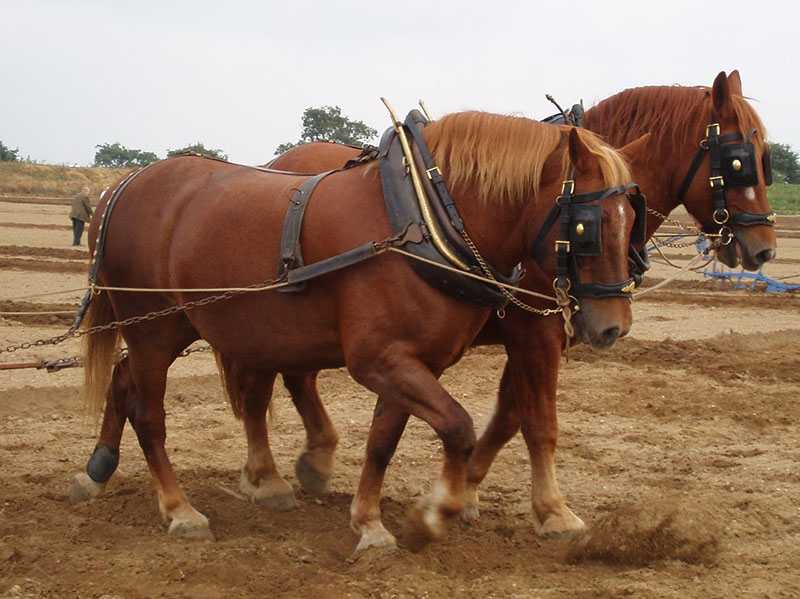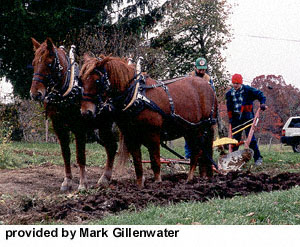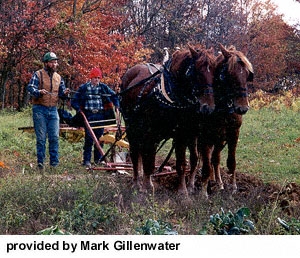Suffolk Horses
 Today's best known breeds of draft horses are said to date back to the great war horses
of Medieval times. But while these great titans clashed in mortal combat, the quiet
farmers of eastern England went about developing their own breed of heavy horse, the
Suffolk Punch. This one breed, is today the least known to Americans, and yet has
perhaps more qualities appealing to the American breeder than any of the better known
breeds of draft horses.
Today's best known breeds of draft horses are said to date back to the great war horses
of Medieval times. But while these great titans clashed in mortal combat, the quiet
farmers of eastern England went about developing their own breed of heavy horse, the
Suffolk Punch. This one breed, is today the least known to Americans, and yet has
perhaps more qualities appealing to the American breeder than any of the better known
breeds of draft horses.
The homeland of the Suffolk horses was Norfolk and Suffolk counties. It was bordered on the north, east, and south by the North Sea, and on the west by the Fens. Isolated from their neighbors, the farmers of Suffolk independently developed breeds of livestock to fit their special way of life. To plow the heavy clay soil they needed an agricultural horse with not only power but stamina, health, longevity, and docility. So these fine husbandmen produced the Suffolk horse and bred into him the attributes that fulfilled their needs.
The Suffolk farmer used his horses to till and harvest his own lands, so seldom did he have horses to sell. This not only kept the Suffolk relatively unknown but also pure, remaining unchanged and true to his original purpose, to be a strong and faithful worker for his master. Of all the draft breeds, the Suffolk is one of the oldest in existence with records dating back to 1880. Crisp's horse of Ufford, the foundation stallion of the breed was foaled in 1768.
 The Suffolk in North America was hard hit by the headlong mechanization of the post
World War II period. Although it had made great strides in popularity during the 30's,
it still did not have the numerical base necessary to withstand the onslaught of the
50's. For a few years the Association ceased to function. Then in the early 60's as
the draft horse market began its recovery, the few widely scattered breeders who had
kept faith with their Suffolks reorganized, holding their first meeting in 15 years
in May of 1961.
The Suffolk in North America was hard hit by the headlong mechanization of the post
World War II period. Although it had made great strides in popularity during the 30's,
it still did not have the numerical base necessary to withstand the onslaught of the
50's. For a few years the Association ceased to function. Then in the early 60's as
the draft horse market began its recovery, the few widely scattered breeders who had
kept faith with their Suffolks reorganized, holding their first meeting in 15 years
in May of 1961.
The early 70's saw some outstanding importations from England. While interest in the draft horse in general was expanding, the demand for Suffolks also began to increase. The early 80's have seen an encouraging increase in the number of Suffolks registered and once again there have been some excellent importations from England.
Conformation
Suffolks are large, symmetrical and uniform in color and type. Their frames are supported by clean, dense bone. Due to their extreme draftiness, the legs of the Suffolk appear short and are strongly muscled in forearms and thighs. They are placed well under the horse and are free of long hair. Their excellent feet are round, of fair size and wear extremely well, shod or unshod.

Suffolks possess intelligent heads with active ears, powerful and arching necks that are clean cut at the throat. The shoulders are inclined to be upright, suitable for power rather than action. The back is short and strong, the ribs springing high from the backbone. The quarters are long and smooth to the root of the tail which springs higher up than in other breeds. The hip bones are wide apart but smoothly covered, the croup usually level.
Depth and thickness from the withers to the leg are essential and a Suffolk should be as deep in the flank as over the heart.
Characteristically the whole appearance of the Suffolk is a pleasant, roundly modeled whole that pertains, like the singleness of color, to no other breed.
The average height of a Suffolk horse is 16.1 hands, but many stallions stand up to 17 hands and more.
Disposition
The Suffolk is a horse of splendid disposition and easy temperament. He exhibits a ready willingness to work, great endurance and the quality known as "Heart", the inner determination to push on. The Suffolk farmer referred to this quality when he said he valued the Suffolk as "a puller of dead weight and indeed a good drawer."
Color
Their color is chestnut, ranging in shade from light golden to the dark liver. White markings occur, but in general are not as prominent as in other breeds, most of them being confined to a star or snip and white ankles or fetlocks. No other color is tolerated or is admissible to registry in the Stud Book.
